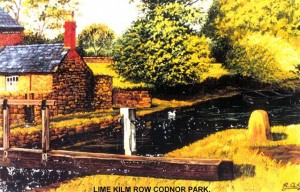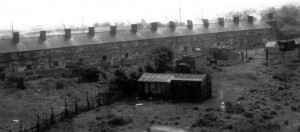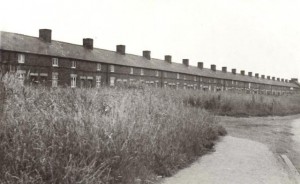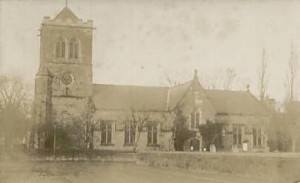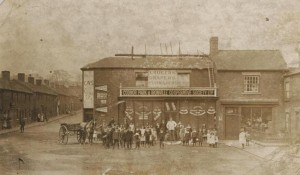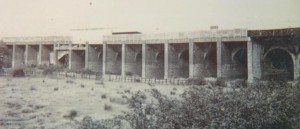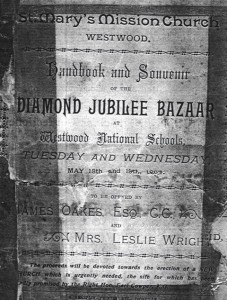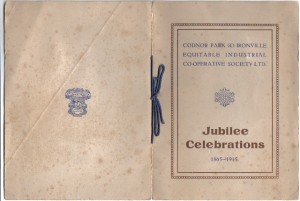Timeline for Jacksdale, Westwood and nearby areas, noting significant dates and events.
Please let us know if you notice any inaccuracies or if you have any relevant dates to add.
1348 It is recorded that a Watermill stood on the River Erewash near to Oakes Row and Meadow St.
1764 Benjamin Outram born at King Street, Alfreton.
1777 Cromford Canal Committee granted royal assent on 30th April.
1778 James Oakes (junior) born.
1779 First section of the Cromford Canal opened on 10th December. Running for 11 miles, from the mouth of the river Sour to Langley Mill.
1784 William Jessop II born. In his later years, Codnor Park Memorial erected in his honour.
1787 The Canal Society rejects plans to extend the Cromford Canal to the source of the River Erewash at Kirkby.
1788 The Canals Committee approve taking the canal from Langley Mill to Cromford, with a branch line to Pinxton from Codnor Park.
1790 Butterley Company established in Ironville.
1792 Water reservoir built by Benjamin Outram & Co, to the rear of The Newlands Pub. Named ‘The Butterley Park Reservoir. This was the first reservoir to be built and is today filled in and forms part of the Midlland Railway Centre’s park grounds.
1792 Pinxton extension of the canal opened.
1797 First iron furnaces built at Codnor Park
1797 Benjamin Outram & Co build the first six cottages at Golden Valley ~ ultimately to be twenty cottages in all built in a continual stone row.
1799 Building of the Upper Wharf commenced.
1800 James Oakes forms Riddings Iron Works with his partners Saxelby and Forester. Trading as ‘Thomas Saxelby & Co’.
1802 Lime Kiln Row built by Benjamin Outram & Co (Butterley Company). A row of 11 cottages along with 4 lime kilns.
1805 Mr David Mushet appointed as manager of Riddings Iron works.
1805 Benjamin Outram dies.
1805 Butterley Company build their second foundry. This ultimately produced 1,766 tons of iron a year - one sixth of iron output for the county of Derbyshire.
1806 Thos Saxelby & Co. achieve highest rate of pig iron production in all of Derbyshire.
1808 Red Road carriageway formed to replace the old bridle path from Jacksdale to Ironville.
1808 David Muchet, manager of Riddings Iron Works leaves and sells his shares in the company to James Oakes.
1808 Thomas Saxelby sells his shares in Riddings Iron Works to James Oakes.
1809 Benjamin Outram & Company change their name to The Butterley Company.
1809 Row of thirteen cottages built by the Butterley Company at Forge Row.
1809 The Butterley Company purchase land from Lancelot Rolleston.
1811 Foundry and Furnace Rows built with a schoolroom nearby. Formerly known as Nether Bullock Close.
1812 Carr Colliery opened. Only mined for one year. Situated South East of the main Butterley Works, off the main Butterley tunnel with the only access via boat.
1812 Jacksdale Street built by Butterley Company Ltd for their employees. The street was first called ‘John Street’ and later known locally as ‘Stone Row’. Built alongside The Portland Wharf which was filled in the 1950s. Jacksdale Street demolished in 1968.
1813 Water mill filled in which stood to the rear of The Newlands Pub at Golden Valley. Two more iron furnaces and a ‘puddling’ forge added to the Ironworks.
1814 William Jessop the Elder died.
1814 James Oakes marries Sarah Haddon.
1816 To 1821. The Butterley Company issued their employees with special tokens,enabling them to purchase goods from the company’s own shop at Hammersmith. This was due to a shortage of minted silver coinage due to the Napoleonic Wars.
1818 Iron foundry at Jacksdale completed.
1818 James Oakes buys Forrester’s shares in Riddings Ironworks and becomes sole owner.
1819 Butterley Company established a savings bank for use by their workers and managed by Mr Humphrey Goodwin.
1820 Pottery built by the Butterley Company on the south bank of the canal.
1821 Portland Pit (later known as Bentinck Pit) sunk.
1821 Butterley Co build All Saints Church and vicarage in Ripley.
1822 Portland Wharf at Jacksdale built.
1822 Tramway running down Wagstaff Lane opened.
1822 Ironville market established at the bottom of King ‘Billy’ Street.
1823 Portland Row, Selston built, which was a continual row of 47 terraced houses with no jennels. (Demolished in 1966).
1823 Butterley Company sink the Smotherfly pit at Somercotes.
1825 Butterley Company sink Ormonde Colliery on their estate. Land to rear of Codnor Castle.
1828 A third blast furnace added to the Ironworks.
1828 Butterley Company sink the Heanor Colliery. Later called Langley but always known locally as Bailey Brook Pit.
1830 Butterley Company brickyard built at the end of Coach Road opposite the reservoir.
1830 Riddings Ironworks has 500 employees.
1830 Grimblethorpe Colliery sunk. Situated behind Newlands Inn near Britain’s Pit Farm.
1831 By this date The Butterley Company had 1,266 employees of which 388 were boys.
1832 Meeting at ‘The Sun Inn’, Eastwood to discuss plans to lay a rail road between Pinxton and Leicester. (6th Aug 1832).
1834 Butterley Company build King William Street at Ironville, which was the axle to their new ‘model village’.
1835 Butterley Company start building King William Public House.
1836 To 1837 Victoria Street, Ironville built.
1836 The Greaves family start the Ironville village post office. The Greaves ran the Post Office until 1895.
1837 Queen Victoria comes to the throne.
1837 Population of Westwood 120.
1837 ‘King William the Fourth’ Public House completed by The Butterley Company.
1840 Albert Street, Tank Street and Meadow Street built at Ironville.
1840 The ‘Big Six’ built at Pye Hill. A pair of Doctors Houses built on the Cinderbank at Ironville. Two additional rows of houses built at Golden Valley.
1841 Village school built at Ironville by the Butterley Company.
1842 Ironville C of E Church built.
1843 Mechanics Institute built on the banks of the canal opposite the end of King Billy Street. Used as the companies offices and also housed a swimming pool and artisans lending library. Built on the site of the old brewery.
1844 The Butterley Company now employed around 2000.
1845 Butterley Company sink Britain’s Colliery at Butterley.
1846 James Oakes Company build Clay Works at Jubilee.
1846 Rev John Casson ~ first Reverend of Ironville Church. Reverend until 1869.
1846 Lime kilns adjacent to Forge House demolished to make way for Midland Railway line.
1847 James Oakes erects world’s first oil refinery at Riddings Ironworks. It yielded 300 gallons a day and was distilled into paraffin oil for lamps. After only 2 years supply diminished.
1847 Selston Lane Built. Pye Hill No 2 Colliery sunk. Selston Lane was originally called ‘New Road’.
1847 Codnor Park & Ironville Station opens.
1849 Pottery on south side of canal purchased by Mr Joseph Bourne & Sons Derby.
1850 Main Road first tarmacadamed and formed part of the Manchester Road.
1850 Mortuary built at the bottom of King William Street along with a brewery.
1850 Ironville became a separate parochial district. It was previously part of the parish of Alfreton.
1851 Census 103 Residents in Jacksdale (55 male & 48 female).
1851 Butterley Company sink Exhibition Pit at Golden Valley.
1852 Casson Street, Ironville completed. Named after the Reverend Casson - first vicar of the parish.
1851 Ironville School enlarged by government grant. Built originally by The Butterley Company.
1851 Cromford Canal sold to The Manchester, Buxton & Midlands Junction Railway.
1852 William Jessop (the 2nd) dies.
1853 First sod laid at Jessop Memorial by WS Greaves local nine year old boy.
1854 Foundation stone laid at Jessop Memorial by Mr Francis Wright.
1855 Avenue of trees planted by The Butterley Company on the Cinderbank, opposite the church.
1855 Codnor Park Colliery closed.
1857 Jessop Memorial completed.
1858 Butterley Company build a brick works at Butterley Park. (Later demolished in1873).
1860 Queen Street and Market Place, Ironville - completed.
1860 (To 1867) ‘The Ironville and Codnor Park Telegraph’ was the locally produced newspaper, which was printed in King ‘Billy’ Street.
1860 Grimblethorpe pit closed.
1861 Census shows that 263 people lived in the 47 terraced houses at Portland Row,Selston of which 117 were children.
1861 Jessop Monument struck by lightning and rendered unsafe.
1862 Ironville church hall built.
1864 New Deeps Pit off Nottingham Lane, Riddings sunk as was the adjacent Cloddy Pit.
1865 Westwood School built and opened on 10th April.
1865 Mr Francis Wright of The Butterley Company presides over a meeting held in the school to form a Co-Operative Society.
1866 Pye Hill Colliery No 1 Shaft sunk.
1866 The Butterley Company now employed 6,000.
1866 The Congregational Movement starts in Westwood and meetings are held in a room above The Royal Oak until a church can be found/built.
1866 Ironville’s Working Men’s Club established (in the mechanics institute) and functioned until 1914.
1866 James Oakes builds workers terraced cottages at Pye Hill.
1867 Butterley Co build St Pancras Station, London.
1868 Congregational Tin Chapel built on Palmerston St.
1868 Primitive Methodist Chapel built at Palmerston St.
1870 By this time, The Butterley Company owned 16 pits and employed 8,000.
1871 Buxtons Hill C of E School opens. First headmaster - Mr William Wagstaff.
1873 Butterley Co Brick works at Butterley Park demolished.
1874 Pye Hill colliery no 2 shaft sunk.
1874 Butterley Co builds United Methodist Free Church built at Pye Hill.
1874 Monument Lane created.
1875 Pye Hill Colliery opens. Arrival of Great Northern Railway Line ( Pinxton to Nottingham.)
1875 Railway Station opens in Jacksdale ‘ Codnor Park & Selston Station’.
1875 Albert and Meadow Street in Ironville, divided into two by railway lines.
1876 Portland Hotel built on site of original pub.
1877 Land Enclosures Act ~ Jacksdale starts to emerge as a village.
1879 960 children from the Parish of Selston were entertained at Monument Hill by Lady Cowper.
1882 Butterley Co build Primitive Methodist Chapel at Pye Hill (now demolished).
1880s Sedgwick Street in existence. Named after the Sedgwick family who built 49 houses here in 1856.
1882 Congregational Chapel opened on Palmerston St on 31st October on the site of the present day United Reform Church. This replaced the original tin chapel.
1883 Until 1886 ~ The Temperance Movement take over the Ironville Working Men’s Club established in 1866.
1886 Mr William Buxton leaves Buxtons Hill School after 15 years.
1886 Ironville by now was a thriving shopping centre, boasting twenty-four shops, mainly situated in King ‘Billy’ Street.
1886 Old furnaces closed in the Forge and replaced by two modern furnaces.
1888 Riddings Gas Works at Pye Bridge established (on site now occupied by Somercotes Rugby Club).
1888 The Butterley Company takes up Limited Status.
1888 Old Deeps Pit at Pye Bridge closes.
1889 Canal tunnel at Butterley Park closed for repairs until 1893.
1890s York Avenue started and then Edward Avenue.
1890 Butterley Co build brickworks at Waingroves Pit also called Marehay Brickyard.
1892 New Selston Colliery ‘The Bull & Butcher Pit’ sunk.
1893 During The Great Strike the 17th Lancers and the 2nd Dragoons kept order in Ironville and were based at the Working Men’s Club.
1897 Queen Victoria’s Diamond Jubilee.
1897 Dixie Street built. Named after Sir Wolston Dixie of Selston Hall. Residents had no water until 1902 so for the first five years had to purchase water from a spring in the valley, by the wharf at a cost of 2/6d.
1897 Population of Westwood 1700.
1897 Bazaar held on Wednesday 19th March at Westwood School to provide the impetus or building a new church in Westwood, which would eventually be St. Mary’s.
1898 Work commences on St Mary’s Church.
Westwood Bazaar 1897
1898 Rev. A Reid appointed Reverend of St Mary’s.
1898 ‘Codnor Park and Ironville Station’ renamed ‘Codnor Park Station.’
1899 St Mary’s Church consecrated by Dr. Were, Bishop of Derby.
1899 Clive House built at the bottom of Wagstaff Lane.
1900 Early 1900s - Worthington family ran a horse brakes transport service to and from Ripley market place every Friday and Saturday.
1900 Pipeworks and Clayworks opened by James Oakes.
1900 Canal tunnel at Butterley park is closed.
1901 Jacksdale railway station changes its name from CP & Selston to ‘Codnor Park Station for Ironville’.
1902 Old Parsonage built at top of Palmerston Street by Earl Cowper.
1902 Albert Avenue built.
1902 St Mary’s Church licensed for weddings.
1902 Bonfire lit on Monument Hill by The Butterley Company to celebrate the coronation of Edward the Seventh and the end of The Boer War.
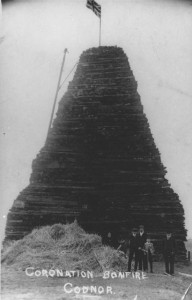
1903 Ironville School became a ‘voluntary’ or ‘non provided’ school supported by Local Rates, with the church being responsible for its upkeep.
1903 Jacksdale Co-Op opened.
1903 Pye Hill Male Voice Choir established.
1904 Present day Social Club built and originally intended to be a butcher’s & slaughter yard.
1904 Jacksdale Miners Welfare opened on 26th March.
1906 Jacksdale School opened. Jacksdale children attended Ironville school prior to its opening.
1908 Jacksdale School opened temporary building 2 tin huts.
1912 Jacksdale Picture Palace opened.
1913 James Oakes & Kempson Co form The Midlands Acid Company at Pye Bridge. Producing sulphuric acid, coal derivatives and tar distilleries.
1913 Butterley Co brickyard at Coach Rd demolished.
1914 Butterley Company build a social club in Ironville.
1914 The Working Men’s Club move to their new premises at The Crossings Club, Ironville.
1914 217 men from Ironville enlisted.
1914 Jacksdale Social Club opened. A limited company was registered on 18th March with starting share capital of £500.
1915 A dance was held in Jacksdale Council Schools to raise money to provide clothing for the Belgian Refugees living in Jacksdale. £16 was raised. Source - R&H 12th Feb 1915.
1915 East window in St Mary’s Church depicting the Ascension dedicated by the Bishop of Southwell on 5th June 1915.
1915 Whit Monday in May - 44th annual temperance fete and gala took place in Codnor Park’s monument grounds. Source R&H 28th May 1915.
1915 August 26th - Auction held at James Pitts farm in Sedgwick Street. Livestock and farming equipment was sold as Mr Pitts was giving up farming. Source R&H 20th Aug 1915.
1918 Prayer desk given to St Mary’s Church in memory of Lydia Louisa Sigourney~Edwards, the church organist.
1919 Butterley Co build brickworks at Kirkby and Ollerton.
1919 Very large celebration at Monument Hill when 3000 celebrated the jubilee of the Co-operative Society.
1920 British Legion created in early 1920s.
1921 Jacksdale War Memorial unveiled (Sat 9th Jul 1921).
1921 Municipal Tip opens on Main Road.
1922 Gate Inn at Westwood built.
1923 Ironville War memorial unveiled (23rd Nov).
1926 Two furnaces closed at Riddings Ironworks due to the Great Strike. Soup kitchens established at the bottom of King ‘Billy’ Street, in Ironville to feed the forge workers children.
1932 Third reservoir built at the top of Monument Lane. (Underground reservoir).Opened on Saturday August 27th of this year.
1932 Original Gospel Hall built in Franklin Road.
1937 Butterley Company build a cricket pavilion at Ironville cricket club.
1935 Old reservoir situated at rear of the Newlands Inn, drained and filled in.
1939 Riddings Ironworks merges with Stanton & Staverley.
1941 Jacksdale Iron Works employs first female workers due to WW2. Called ‘The Sunshine Club’ and employed on the manufacture of farm implements to help with the war effort.
1943 Jacksdale Iron Works has its own medical service, which was available until 1969.
1943 Stretch of canal between Hammersmith and Cromford closed.
1945 Cromford Canal closed.
1947 The end of the Butterley era of mine ownership with the nationalisation of the coal boards.
1947 James Oakes Co changes its name to OANCO.
1947 The chapel on the North side of the chancel in St Mary’s Church was dedicated by the Archdeacon RP Wilson on the 15th of June.
1950s Portland Wharf filled in.
1950 Jacksdale station changes its name from CP for Ironville to ‘Jacksdale Station’.
1950 Stanton & Staverley of Riddings Ironworks incorporated within British Steel.
1952 Font cover and cradle rolls donated to St Mary’s Church by the Sunday School as a Golden Jubilee present.
1952 The plaque to those who fell in the Second World War was unveiled on the 16th November, by the Duke of Portland.
1956 Co-Operative Bakery in Dixie Street closes.
1956 Kirton brickworks at Ollerton opened.
1956 Extensive modernisation at Pye Hill pit. New baths built. Electric winders installed.
1959 Bull & Butcher Pit at Selston closed.
1959 Soldier on top of Jacksdale War Memorial blown down in storm.
1960 Coal preparation plant built at Pye Hill Colliery.
1960 Extension to St Mary’s Churchyard completed.
1962 Ironville Church Hall Built.
1963 Jacksdale Station closed on 7th January.
1964 Pye Hill No 1 shaft filled in.
1965 Codnor Park Forge closed.
1966 800 yard drift sunk at Pye Hill Colliery to improve ventilation and increase production.
1966 Portland Row, Selston demolished.
1966 The stretch of canal between Jacksdale & Langley Mill filled in by local farmers.
1967 Pye Hill United Methodist Free Church at Pye Hill demolished due to subsidence.
1967 Codnor Park Station closed and demolished.
1968 Jacksdale Street demolished.
1969 Butterley Company sold.
1969 Riddings Ironworks closes.
1971 Acid works at Pye Bridge closes.
1972 Swimming pool installed at Ironville School. Nursery school built on the corner of Casson Street.
1973 Original tin huts erected in 1908 as temporary structures at Jacksdale School finally removed. New kitchen and infants wing added.
1973 The old King ‘Billy’ Street demolished along with Furnace and Foundry Rows.
1974 Stained glass window ‘The Shepherd and the Sheep’ donated to St Mary’s Church by Ida and John Worthington.
1974 Jacksdale station and viaducts demolished. Also Launder’s Cottage on Community Centre site.
1974 Municipal Tip closed.
1974 Round kiln at James Oakes pipe yard closed.
1976 The old pipe organ at St Mary’s church was dismantled and sold to be replaced by an electric version.
1976 Forge demolished.
1977 Jacksdale ‘open air’ market started.
1978 Piper Seam developed at Pye Hill pit.
1979 Primitive Methodist Chapel on Palmerston Street demolished along with the rest of Palmerston Street.
1980 Vicarage built on Church Hill.
1981 Coach Road reservoir came under threat when the Waterways Board proposed it be filled in and used as a tip. Planning permission was denied.
1981 Gospel Hall on Franklin Road gutted and rebuilt.
1981 Old caretaker’s house next to Westwood School converted into a Pre-School Nursery.
1982 Jacksdale Community Centre opened on 22nd January 1982.
1983 Esso oil company given permission to test drill for oil at Monument Hill.
1983 Experimental pelletisation plant opened at Pye Hill Pit but lasted only one year.
1985 Congregational Chapel at Palmerston St demolished.
1985 Pye Hill Colliery closes. Black shale seam exhausted.
1986 United Reform Chapel built on Palmerston St on old Congregational Chapel site.
1987 James Oakes Clay Works at Jubilee closed.
1988 Baths and Canteen demolished at Pye Hill Pit.
1991 Jacksdale Nature Reserve opened by botanist David Bellamy on old municipal Tip site on Main Road.
1992 Councillor Jack Brown calls for Jessop Monument to be restored.
1993 Industrial Units opened at Pye Hill.
1995 Hanson Corporation take over Butterley Brick works at Ollerton.
1996 Pre-School Nursery added at Jacksdale School.
1997 Jacksdale War Memorial name plaques replaced and re-dedicated.
1997 Jack in a Box Playgroup moves into Jacksdale School.
1998 Cast iron bridge, over canal removed for safety reasons.
2002 Jacksdale & Westwood are national runners up and regional winners in the Calor Gas Village of the Year awards. The competition is televised on Living TV.
2006 Jacksdale Picture Palace demolished to make way for a new Co-operative Store. Portland Arms Public House demolished, land raised up to avoid flooding and then used for new housing.
2009 Jun 14th - New soldier statue unveiled on Jacksdale War Memorial.
2009 Jacksdale School wall mosaics unveiled.











